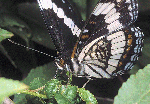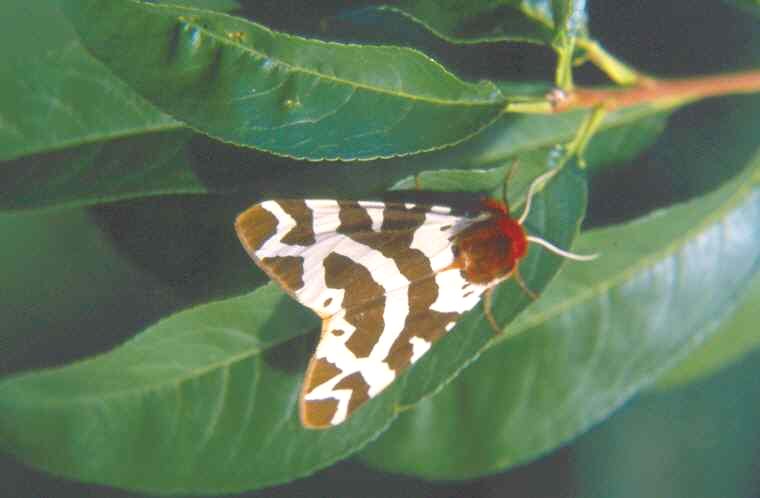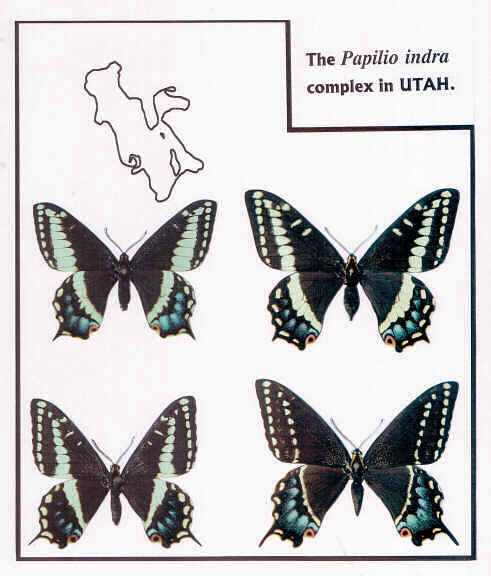
Utah Lepidopterists' Society
Founded 6 Nov 1976

|
|
Utah Lepidopterists' Society Founded 6 Nov 1976 |
|
| History | Mission | Meetings | Bulletin | Checklists | Links | Community | Field Trips | Habitat | Members | Kids | Contact Us |
|

|
|
|
|
Previous lepidoptera publications describing the Papilio indra complex
have labeled it as rare, fragile, isolated, and so forth. For example, William
H. Howe describes it as follows: "The Papilio indra
complex shows a considerable degree of geographic variation, especially in the
southern parts of its range. Throughout its range the species is generally
uncommon and specimens are rare in collections."
Clifford D. Ferris and F. Martin Brown add, "Because of its isolated
habitats, indra is poorly represented in collections."
Furthermore, according to John Adams Comstock, speaking of P. indra
indra in Calif, "is one of our rare species, occurring in
the higher altitudes of the Sierras...It is a difficult butterfly to capture,
being rapid and erratic in flight." (Italics added.) But today,
because of work by researchers and by many collectors who have become
impassioned with indra, we know that it is not only more common than
previously perceived--it has been recorded in every county in Utah save four;
Sanpete, Iron, Wasatch, and Piute--but also, it is well represented in some
collections.
The Papilio indra complex in Utah flies in a variety of habitats from
desert swells, reefs, and limestone hills to the tops of the Wasatch Mountains.
In fact, the butterfly has even been seen crossing valley floors between
mountain ranges! It is true that indra does fly in some hostile
environments. Its population numbers have been known to fluctuate drastically
from year to year depending upon climate and parasitism. A large colony of P.
indra minori in Emery County, was all but depleted between 1993 and 1995
due to heavy parasitism. Fortunately, this year (1996), minori has made
a recovery there. One of the population stabilizing mechanisms of indra
is the fact that their pupae can prolong diapause for several years in order to
insulate against harsh or unfavorable conditions.
One of the elements that gives indra such an appeal to some collectors
is its beauty coupled with its geographic variation. The indra swallowtail's
geographic variation is peculiar in the effect that colonies which fly in moist
montane habitat such as P. indra indra show much less individual
variation than do colonies from the desert or from a semi-arid origin such as P.
indra nevadensis or P. indra minori. The same phenomenon also
seems to occur in California as montane colonies of pergamus and indra
indra show a lower degree of individual variability as compared to the
desert races of fordi and martini.
Utah currently has four varieties of indra; three named subspecies
which include the typical race, minori, nevadensis, and one
unnamed variety, "bonnevillei." Unlike its cousins from the machaon
group, Papilio indra adults are not sexually dimorphic. In many Utah
habitats, excepting most colonies of P. indra minori and P. indra
nevadensis, indra flies sympatric with Papilio zelicaon;
the former usually flying 7 to 10 days after the latter. The two species also
share many of the same larval foodplants. However, zelicaon generally
has a broader base of foodplants as compared to indra.
Although difficult and time-consuming, many collectors have been able to obtain
attractive series of the different varieties of indra through rearing
its caterpillars. One of the difficulties of rearing indra in the lab
is the few species of plants--usually in the Lomatium and Cymopterus
genera--which the caterpillars will accept. Obtaining these specific plants many
times requires long distance travel to obtain. Another problem with raising indra
in the lab that can be overcome through practices later discussed in this
publication is their high susceptibility to microbial death. The two most common
varieties of microbes that kill indra immatures are viruses and
bacteria.
Others have obtained a decent series of some races of P. indra by
collecting adults on the wing. Although Comstock describes the butterfly as
being difficult to capture and erratic in flight, a little patience can overcome
this obstacle through observation. In other words, indra males
oftentimes will repeat their "erratic" courses as they fly similar
aerial routes and land generally in the same spots. By predicting this
repetitious behavior, specimens can be netted more easily. Some higher altitude
males of P. indra indra exhibit this repetitive flying behavior, and
have even been known pause from their aerial stunts in order to land and bask on
snow banks!
Females, on the other hand, are much easier to capture as they more casually
flitter in the vicinity of their larval hostplants. (The only exception to this
is females of P. indra minori which tend to traverse their habitat in
search of larval hostplant with much more haste.)
PART I: THE FOUR UTAH VARIETIES OF PAPILIO INDRA
Papilio indra indra
General:
The Type Locality of P. indra indra is vicinity of Empire, Clear Creek
County, Colorado; Reakirt 1866. It is the shortest tailed race; some individuals
exhibiting nothing more than a "stub." The nominate race is univoltine.
The flight period in Utah varies depending upon elevation, snowfall, and larval
hostplant. In the Bear River Mountains and in other isolated locations along the
Wasatch Front where indra indra utilizes Lomatium grayi var. grayi
between the elevations of 5000' to 7000', indra flies from mid-May to
late July.
On the other hand, higher up in the Wasatch Mountains, where the larval
hostplant (L. kingii) grows at around 8000' to 10,000', the flight
period varies from around mid June to early September.
Utah Distribution and Habitat:
As discussed previously, the montane habitat of P. indra indra includes
the Wasatch, Oquirrh, Stansbury, Bear River, and Uinta Mountain Ranges. Higher
altitude males patrol and perch all day in search of females. Some of these
males have been known to descend several thousand feet to canyon floors to
nectar near rivers. (I.e, Provo Canyon, Utah County, and Big Cottonwood and
Millcreek Canyons, Salt Lake County.)
Bionomics:
As stated earlier, the principal larval foodplant for P. indra indra in
the Wasatch Mountains is Lomatium kingii (narrowleaf lomatium,) and the
larval foodplant in the Bear River Mountains is Lomatium grayi var. grayi (milfoil
lomatium.)
The ova is yellow-green, and is laid principally on healthy plants' peripheral
ventral stalks. After a day or so, the ova develops rings and then turns black
before hatching. From the time an egg is laid to the time it hatches is roughly
six days in nature and five days in the lab. (Assuming room temperature.)
The young first instar larva is black with a thin, white saddle. As the larva
moults into later instars, small white and yellow-orange speckles appear. Larvae
of P. indra are much more timid than those of P. zelicaon.
The mature larva varies from black with off-white stripes to nearly all black
with small yellow-orange dots. Hibernation is as pupa. For some reason, most
lab-reared pupae emerge after two years of winter. Some pupae have been known to
diapause for up to seven years.
Papilio indra minori
General:
The Type Locality of P. indra minori is Black Ridge Breaks, Mesa
County, Colorado; Cross 1936. Minori is one of the most beautiful races
of P. indra. Its large size with long tails combined with thin to
intermittent cream bands and generous blue dorsal hindwing scales are
diagnostic. Adults display a significant amount of individual variation. The
bands on some individuals of minori are completely obsolete; showing
the phenotype of what essentially is a black and blue swallowtail. It is the
opinion of the author that this form kaibabensis which most authorities
treat as a distinct subspecies really is a genetic drift morph of minori for
two reasons. First, the kaibabensis form appears at least seldomly in
mostly all minori populations. Again, its just an example of individual
variation. Second, the habitat and bionomics of the two taxa are virtually
indistinguishable.
Males hilltop on the tops of reefs, buttes, or even sheer peaks in search of
females. In fact, minori males have shown intense aerial battles
against one another in competition for females. Females, on the other hand,
oftentimes fly in lower portions of buttes, or even in desert floors or swells
in search of its larval hostplant. (Females only hilltop once to mate.) It is
multivoltine depending upon rainfall; with up to three broods per year.
Utah Distribution and Habitat:
The distribution of minori in Utah is considerable. According to W.H.
Whaley, over 50 distinct colonies can be found over Central to
South-Southeastern Utah badlands. This distribution includes, but is not limited
to, the West Tavaputs Plateau, Cedar Mountain, San Rafael Swell, San Rafael
Reef, Capitol Reef National Monument, Henry Mountains, Cockscomb Ridge, La Sal
Mountains, Abajo Mountains, and Monument Valley south to Northern Arizona.
Bionomics:
The larval hostplants of minori differ depending upon venue. In the San
Rafael Swell, Cedar Mountain, San Rafael Reef, Capitol Reef National Monument
areas, larvae utilize Lomatium junceum (rush lomatium.) At the
Cockscomb Ridge, Monument Valley, and Abajo Mts, larvae use Lomatium parryi (parry
desert parsley.) Also at Monument Valley and areas adjacent to Moab, larvae use Cymopterus
terebinthinus (rock springparsley.) All of these larval hostplants are
unique because they, for the most part depending upon rainfall, stay green and
healthy from spring until fall; which accounts for the butterfly's ability to
have multiple generations in one year.


Photos: Lomatium junceum & Lomatium
junceum (closeup with ova)
The ova is yellow-green; developing rings and then turning black before
hatching. The young larva is black with a white saddle. It is interesting to
note that young minori larvae have a broader white saddle than young indra
indra larvae have. The large mature larva is gorgeously arrayed with bright
pink and black stripes strewn with orange dots. Immatures, unfortunately, are
heavily subjected to several varieties of parasites. Egg parasites have recently
been discovered in addition to the ever-so-prevalent small wasp parasites that
kill third instar larvae and maggot parasites that kill fifth instar larvae.
Hibernation is as pupa.
Papilio indra nevadensis
General:
The Type Locality of P. indra nevadensis is Jett Canyon, Nye County,
Nevada; Emmel and Emmel 1971. In Utah, P. indra nevadensis is also
known as P. indra nr. nevadensis. It is a long tailed race of indra.
Amongst all the varieties of indra in Utah, nevadensis shows
the most drastic example of individual variation with specimens looking like fordi,
martini, panamintensis, and even pergamus. Nevadensis for
the most part is univoltine with less than 1 percent of lab-reared pupae
emerging during the same year. Adults of the Nevada Swallowtail fly early in the
year; from mid to late March to early May.
Utah Distribution and Habitat:
The distribution of nevadensis in Utah is restricted to Washington
County.
Bionomics:
Nevadensis immatures utilize two species of Lomatium in
Washington County. In the vicinity of St. George, Lomatium scabrum
(cliff lomatium) is the larval hostplant. Leaflets of L. scabrum burn
off by mid to late May; which accounts for its one brood. However, leaflets of Lomatium
parryi, which is its foodplant, further north, do not burn off until the
fall. As such, it is plausible that nevadensis could at least have a
partial second brood. Admittedly, more research needs to be done in this area.
Under typical conditions, females will only lay on healthier L. scabrum plants
located between rocks or at the base of desert washes because these plants will
thrive long enough to support the larva to maturity. However, in certain years,
when population numbers are extremely high, it is interesting to note that
females sometimes will oviposit on plants that cannot support the larva to
maturity. Some Navajo Sandstone hills in Washington County do not have Lomatium
scabrum on them except for North-facing washes and slopes. These hostplants
only exist and survive there for two reasons: First, these washes and slopes
accumulate more moisture and can support the roots of these plants. Second,
plants in this area receive less direct desert sunlight as compared to south,
east and west facing slopes.
The mature larva is similar to P. indra minori and is striped with
bright pink-peach and black bands with yellow-orange spots. The pupa is salmon
in color and camouflages well against Navajo Sandstone. As is true with all
subspecies of indra, hibernation is as pupa.
Papilio indra "bonnevillei"
General:
Currently, "bonnevillei" is an unnamed race of Papilio indra.
The name was originally under consideration by C.F. Gillette in 1987 and later
dropped. Currently this unnamed race, also regarded as "West Desert indra"
by local collectors, is being researched and considered to be named as a
subspecies by W.H. Whaley.
The presenter of this publication feels that "bonnevillei" should have
subspecific recognition for several reasons: First, "bonnevillei" is
geographically isolated from nevadensis or nr. nevadensis.
Second, P. indra nevadensis never have short-tailed morphs; P.
indra "bonnevillei" does. Third, over a long series, "bonnevillei"
has consistently more blue in the dorsal hindwings as compared to nevadensis.
Fourth, some "bonnevillei" females exhibit extremely wide dorsal
forewing bands that rival even P. indra fordi let alone nevadensis.
Fifth, nevadensis documented larval hostplant Lomatium scabrum
grows where "bonnevillei" flies. However, to date, "bonnevillei"
immatures have not been found on it. Sixth, mature larvae of "bonnevillei"
are drastically different to Washington County nevadensis.
"Bonnevillei" is short to medium tailed, and has one flight per year.
The flight varies depending upon winter precipitation. At 5000', "bonnevillei"
generally flies from mid/late April to mid/late May.
Utah Distribution and Habitat:
Colonies of "bonnevillei" exist in many North-South ranges in Utah's
West Desert including but not limited to the Dugway Range, Thomas Range, Fish
Springs Range, House Range, Confusion Range, Little Drum Mountains, and Wah Wah
Mountains. All of these mountain ranges contain Limestone and exist in the
vicinity of what was Lake Bonneville. These limestone hills is where the larval
hostplant lives.
Bionomics:
The larval hostplant is Lomatium grayi var. depauperatum. This plant
seems to die off faster than any other host of indra. The young larva
has perhaps one of the most slender white saddles as compared to other
subspecies of indra. As the larva matures, this saddle has been known
to disappear altogether. Third instar larvae of "bonnevillei" change
their resting position to the base of the hostplant where they are difficult to
find. The mature larva has two basic forms from mostly black with tiny yellow
dots to black with medium cream bands. The mature larva somewhat resembles the
larva of P. indra indra.
Utah Papilio indra Subspecies and Larval Foodplant Matrix
|
Food Plant |
P. indra indra |
P. indra minori |
P. indra nevadensis |
P. indra "bonnevillei" |
|
Lomatium grayi var. grayi |
dLF |
NO |
NO |
YES |
|
Lomatium grayi v. depauperatum |
YES |
NO |
NO |
dLF |
|
Lomatium junceum |
YES |
dLF |
YES |
YES |
|
Lomatium kingii |
dLF |
YES! |
YES! |
YES! |
|
Lomatium parryi |
??? |
dLF |
dLF |
??? |
|
Lomatium scabrum |
??? |
??? |
dLF |
NO |
|
Cym. terebinthinus |
YES |
dLF |
dLF |
YES |
**All subspecies of P. indra will gladly
and readily accept L. kingii.
dLF = = Documented Larval Foodplant
YES = = Suitable Lab Foodplant
NO = = Not Suitable Lab Foodplant
??? = = Unknown




(B) P. i. "bonnevilli" 5th instar on L. grayi
(C) P. i. minori 4th instar on C. terebinthinus
(D) P. i. minori 5th instar on L. junceum
References
1. Emmel, Thomas C. and Emmel, John F. 1973. The Butterflies of
Southern California p. 12.
2. Howe, William H. 1975. The Butterflies of North America p. 396.
3. Ferris, Clifford D. and Brown, F. Martin 1981. Butterflies of the Rocky
Mountain States p. 184
4. Comstock, John Adams. 1927. The Butterflies of California, p. 21
5. Gillette, C.F. Col. Utahensis: Journal of the Utah Lepidopterists' Society
l984 4.2, p.34.
6. Whaley, W.H. Personal Communication. 17 Jul 1996.
7. Gillette, C.F. Col. Personal Communication. 5 Jul 1996.
8. Whaley, W.H. ibid.